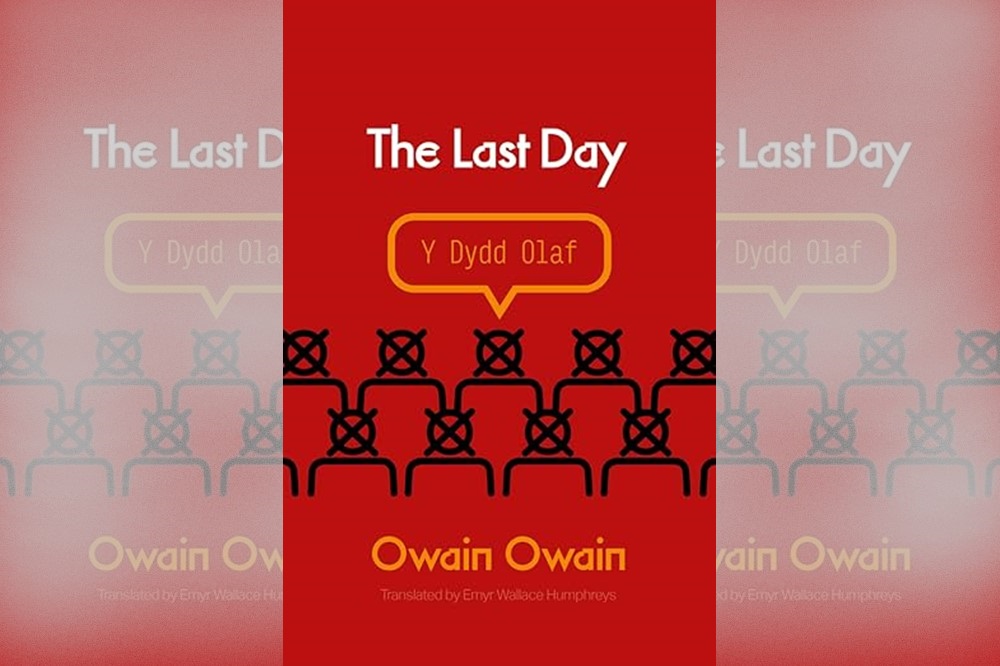Book review: The Last Day/Y Dydd Olaf by Owain Owain

Jon Gower
Described as the trippiest Welsh language novel ever by its translator, Emyr Humphreys Wallace, it’s hard to argue against this description of Owain Owain’s oddball novel.
The Last Day first saw the light of day in 1976 as Y Dydd Olaf and not only is it as trippy as a hearty mugfull of magic mushroom soup, it is also a very rare example of speculative or science fiction in Cymraeg.
It’s not a genre much present in the literature, which possibly accounts for the impact of its publication and for its lingering effect. It inspired an album by Gwenno and has now attracted the attention of Emyr Humphreys Wallace, who was keen to share its complexities with an English-speaking audience.
The book is not without its challenges for a translator, but there is one small consolation, perhaps, in that some passages don’t need conversion at all as they’re in a made-up language of the future.
This turns out to be a deadly formulation, a language seemingly out to replace other languages and part of the general brainwashing and assimilation process that turns people of free will into automata.
Hypnotic
Some phrases in this Esperanto-like language recur time and time again, mantric and hypnotic, replacing whatever words were previously there. Fratolish hiang perpetshki. Fratolish hiang perpetski. In its presence and persistence we can see why the book has been called ‘a moving call to arms for speakers of minority languages facing extinction.’
It is of course a totally different experience to read it in English, a globally represented language compared with the original Welsh, which this reader now fully intends to do.
Dystopian
The book itself supplies two useful reference points for the reader in the opening paragraphs of its prologue. Here it name checks both Nineteen Eighty-Four and Brave New World, suggesting to the reader that the future world it describes is more dystopian than utopian. Indeed the book’s chronology underlines its connections with George Orwell’s dark imaginings as some of it is actually set in the year 1984, where we find out about its central figure Marc’s middle-age.
Much of the story in The Last Day is presented in the form of diaries, making time itself more than usually apparent in a work of fiction. And yet, Marc cautions us, ‘If life has taught me anything, it’s that time – the time that’s measured by the fragile stimuli of life – doesn’t belong to the ticking clocks or calendar pages.
There’s not much relation – is there any? – between these two times: clocks don’t measure the length of ages, and calendars don’t measure eras.’ But we do learn things from Marc’s journal entries, not least about his early adulthood, which he remembers in vivid scenes, featuring his friends and the women he has loved, especially Anna, a love who slipped away from him. We hear about his student days. Meet his Aunt Bodo who has wallpapered her house in pink and orange. See his mother making blackberry jam from fruit Marc and his friend Pedr have picked in Y Winllan.
The Last Day, spanning the period from 1948 to the last day of the 20th century is uncommonly prescient in its discussion of AI, as befits a writer who was not only a language campaigner and founded Cymdeithas yr Iaith’s house magazine Tafod y Ddraig but was also a physicist. So there’s a lot of science and quasi science in the book, along with references to other books of science such as Electronics: Alphabet of the Future.
Abomination
In July 1999, as humanity’s clocks edges towards the cusp of the millennia, Marc records the sighting of an unhuman abomination, confirming the many rumours of their existence and appearance, the fruits of early, failed experiments. We never learn the exact nature of such experiments, but the story hints darkly at what they are meant to produce, such as when we learn about the meals the human guinea pigs, the so-called Sunseteers are being served:
These feed pellets are for cows, of course. So that They can have meat. I laugh out loud! I might as well. It’s such a surreal state of affairs. It’s like a dream – everything is topsy-turvy, but still making some kind of sense within the framework of the dream.
Serving us cattle feed so They can have meat! Are there really any cattle? Where are they? Where are the lush grasslands, and where are the springs still silently flowing?
Puzzles
Where are they indeed. This is a book chock full of puzzles and conundrums, not least as we chart the dismantling of Marc’s mind and memories as he is slowly dehumanised, so that shards of the past lance into a future. The curlews crying for rain. The seagulls screeching above the shore. The ripeness of blackberries ready for picking.
During a two month long process, presided over by the Computer-General, Marc slowly loses his identity and will. And along with that a language disintegrates and a language speaker is lost. It’s a process wilfully and systematically imposed upon him by powerful others, and therein is one of the hidden lessons in this modernist, trippy, mind-boggler of a book.
The Last Day/Y Dydd Olaf by Owain Owain is published by Parthian Books. It is available from all good bookshops.
Support our Nation today
For the price of a cup of coffee a month you can help us create an independent, not-for-profit, national news service for the people of Wales, by the people of Wales.




